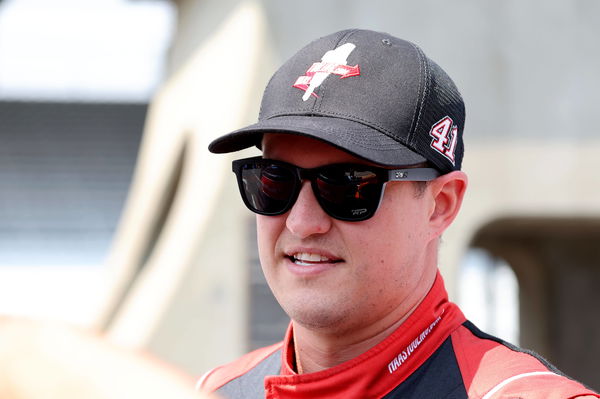
Imago
NASCAR, Motorsport, USA Brickyard 400 Qualifying Jul 20, 2024 Indianapolis, Indiana, USA NASCAR Cup Series driver Ryan Preece 41 during qualifying for the Brickyard 400 at Indianapolis Motor Speedway. Indianapolis Indianapolis Motor Speedway Indiana USA, EDITORIAL USE ONLY PUBLICATIONxINxGERxSUIxAUTxONLY Copyright: xMikexDinovox 20240720_mcd_ad4_20

Imago
NASCAR, Motorsport, USA Brickyard 400 Qualifying Jul 20, 2024 Indianapolis, Indiana, USA NASCAR Cup Series driver Ryan Preece 41 during qualifying for the Brickyard 400 at Indianapolis Motor Speedway. Indianapolis Indianapolis Motor Speedway Indiana USA, EDITORIAL USE ONLY PUBLICATIONxINxGERxSUIxAUTxONLY Copyright: xMikexDinovox 20240720_mcd_ad4_20
Testing for the 2026 NASCAR Cup Series season has officially started, and for once, there is true optimism in the air instead of just hope. A few teams unloaded at Bristol Motor Speedway for a unique Goodyear tire test just one week ago. Their mission was to check for two things fans have been begging for. More horsepower and less falloff. All because many were disappointed by Bristol’s most recent race.
Watch What’s Trending Now!
However, the voices emanating from the garage sounded different this time. There’s actual advancement. genuine potential. The 750HP package being tested could bring back something NASCAR has been missing for years: throttle control, tire wear that matters, and battles where driving skill actually decides the outcome. And no one summed up the stakes better than Ryan Preece.
ADVERTISEMENT
Ryan Preece explains why NASCAR needs more horsepower
On the latest episode of the Dale Jr. Download podcast, Ryan Preece didn’t dance around his point. He was as straightforward as he could be. “Over time and as we continue to go down this path, I’d like to see an increase in horsepower,” he stated. And for 2026, that’s finally happening. The current offseason test at Bristol is setting the stage for a bump to 750 horsepower at all tracks under 1.5 miles.
This includes Bristol, Darlington, Dover, Nashville, and World Wide Technology Raceway. By increasing horsepower, NASCAR hopes to force drivers to better manage throttle application and tire wear, making the racing more dynamic and challenging for both competitors and crews.
This change is a response to feedback from drivers like Preece, crew chiefs, manufacturers, and fans who have called for more power to improve short-track and road-course racing. Preece also talked about modifications to the car’s aerodynamics, like using fewer rear diffuser strakes or, in certain testing, eliminating the diffuser.
ADVERTISEMENT

Imago
NASCAR, Motorsport, USA Xfinity: NASCAR Xfinity Series Playoff Race at Bristol Sep 12, 2025 Bristol, Tennessee, USA General view during the Food City 300 at Bristol Motor Speedway. Bristol Bristol Motor Speedway Tennessee USA, EDITORIAL USE ONLY PUBLICATIONxINxGERxSUIxAUTxONLY Copyright: xRandyxSartinx 20250912_tbs_bs1_132
The diffuser, a plate underneath the car’s back, aids in directing air to improve stability and downforce. Reducing strakes increases tire slip and driver skill by reducing downforce. However, it can also cause cars to “fight the same problem” of following closely and fewer overtakes, particularly in dominant lanes.
ADVERTISEMENT
“There will be a point where we can’t probably go any softer because we’ll, you know, to your point, we’re going to damage the tires. We’re going to blow them apart, and that’s going to be on us.” Preece said of the limitations of softer Goodyear compounds in relation to tire wear. This risk was demonstrated in the 2025 Bristol event when Josh Berry, Austin Cindric, and Chad Finchum’s Fords experienced fire and smoke issues due to aggressive tire choices. More horsepower means the balance between excitement and durability remains delicate.
By the conclusion of the Bristol tire test, Preece was optimistic. “Feel like [we’re] finding the right direction,” he said earlier. As NASCAR heads into the 2026 season, the innovations in power, aerodynamics, and tire selection promise fresh action. Perhaps, we will see a return to the gritty, unpredictable racing that fans love most.
ADVERTISEMENT
NASCAR’s new OEM testing rules for 2026
Longtime NASCAR insider Bob Pockrass has revealed how NASCAR is strengthening its regulations on manufacturer testing for 2026. The new regulations, which apply to all three national series, are intended to provide a more equitable playing field while controlling expenses.
If you follow NASCAR closely, you already know how vital OEM testing is. Here, manufacturers adjust engine performance, aerodynamics, and overall setup while adhering to NASCAR’s stringent regulations. It’s also closely monitored to ensure no team gains an unfair technological edge.
Under these updated regulations, any new OEM entering the sport, like Dodge (defined as one that hasn’t competed in the last five seasons), will face specific limits. They’ll be allowed a maximum of three testing sessions, and each session can run for no more than two consecutive days.
ADVERTISEMENT
NASCAR also added some flexibility to account for weather interruptions, ensuring sessions aren’t unfairly cut short. All testing must be wrapped up by March 1 of the season year, setting a firm preseason window. But the rulebook gets even stricter. Testing can’t take place at any track that’s been newly added to the schedule or recently repaved. e.g., San Diego street course at Naval Base Coronado.
And to keep the schedule fair for all, no OEM testing is allowed at any track within 60 days of a race weekend at that venue. That prevents teams from sneaking in valuable data just ahead of competition. There’s also a cap on scale. Each test session can involve up to three affiliated organizations, and they’re permitted no more than two cars apiece. This prevents powerhouse teams from stacking the field with data-gathering resources while ensuring testing remains efficient rather than exhaustive.
These regulations essentially achieve a balance by promoting innovation without sacrificing budget or parity. NASCAR desires cost-effective, competitive racing. And these new guidelines are designed to keep every OEM honest, prepared, and playing by the same rules.
ADVERTISEMENT
ADVERTISEMENT
ADVERTISEMENT

